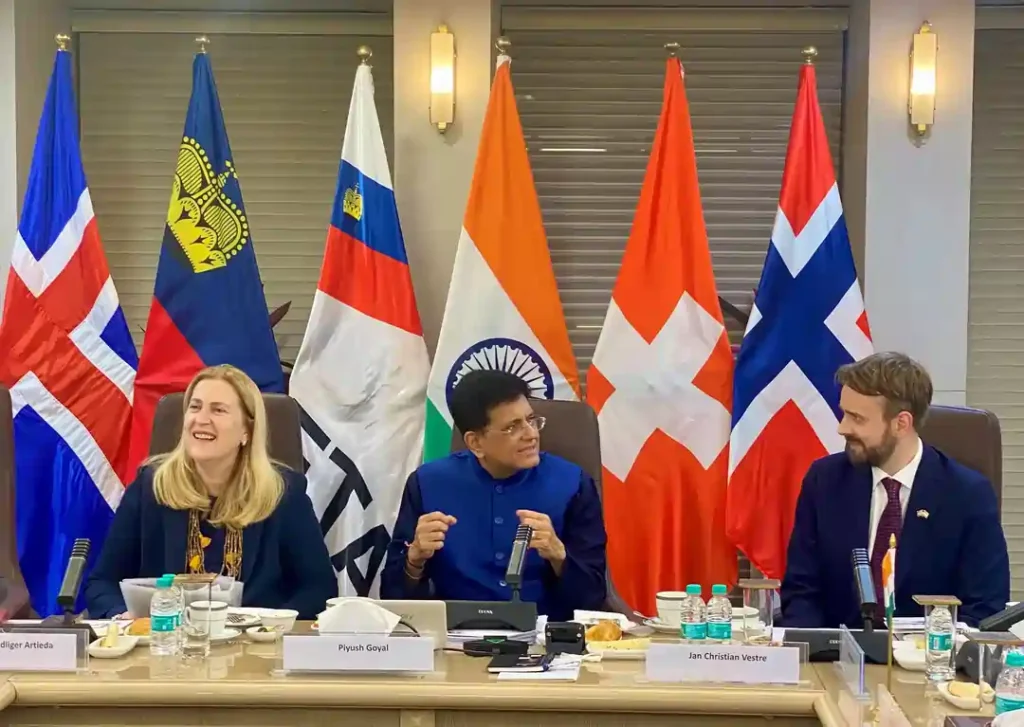New Delhi: On October 1, 2025, the India–European Free Trade Association (EFTA) Trade and Economic Partnership Agreement (TEPA) officially entered into force, marking a historic milestone in India’s economic relations with Iceland, Liechtenstein, Norway, and Switzerland. Signed on March 10, 2024, in New Delhi, TEPA is India’s first Free Trade Agreement (FTA) to incorporate binding commitments for $100 billion in foreign direct investment (FDI) and the creation of 1 million direct jobs over the next 15 years. With a combined GDP of approximately $5.4 trillion, India and the EFTA bloc—comprising some of Europe’s most advanced economies—are poised to redefine global supply chains, foster sustainable development, and enhance bilateral trade. Hailed as a “model agreement,” TEPA aligns with India’s Make in India and Atmanirbhar Bharat initiatives, promising transformative growth across diverse sectors.

Caption: India-EFTA TEPA Takes Effect: Unlocking $100 Billion in Investments and 1 Million Jobs for a Prosperous Future
A New Era of Economic Partnership
The TEPA, celebrated at the Prosperity Summit in New Delhi hosted by Commerce and Industry Minister Piyush Goyal, brings together senior EFTA representatives, including Swiss State Secretary Helene Budliger Artieda and ambassadors from Iceland, Liechtenstein, and Norway. Business leaders from both sides convened to explore opportunities in precision manufacturing, clean technology, and services mobility. The agreement’s 14 comprehensive chapters address market access for goods, rules of origin, trade facilitation, trade remedies, sanitary and phytosanitary measures, technical barriers to trade, investment promotion, services, intellectual property rights (IPR), trade and sustainable development, and legal provisions. This holistic framework streamlines customs procedures, reduces regulatory barriers, and fosters closer value-chain integration.
EFTA, alongside the EU and UK, is a critical economic bloc in Europe. Switzerland stands as India’s largest EFTA trading partner, followed by Norway, with Iceland and Liechtenstein offering additional avenues for trade. In 2024, India’s agricultural exports to EFTA reached $72.37 million, representing 0.41% of EFTA’s total imports, while engineering exports hit $315.2 million, reflecting an 18% year-on-year growth. Textiles and apparel exports stood at $0.13 billion, a fraction of India’s $36.71 billion global textiles trade, signaling significant untapped potential under TEPA.
Unprecedented Investment and Employment Commitments
Under Article 7.1 of TEPA, EFTA states commit to increasing FDI into India by $50 billion within the first 10 years, followed by an additional $50 billion in the subsequent 5 years, totaling $100 billion (approximately Rs 8 lakh crore). This excludes foreign portfolio investments, focusing solely on long-term capital to build productive capacity. Concurrently, the agreement aims to generate 1 million direct jobs, supporting India’s young workforce through enhanced vocational and technical training. These commitments bolster Make in India by driving investments in renewable energy, life sciences, engineering, and digital transformation, while fostering technology collaboration in precision engineering, health sciences, and research and development.
Robust Market Access for Goods
TEPA delivers extensive market access for goods, with EFTA offering 92.2% of its tariff lines, covering 99.6% of India’s exports, including 100% of non-agricultural products and concessions on Processed Agricultural Products (PAP). India reciprocates by opening 82.7% of its tariff lines, accounting for 95.3% of EFTA exports, with over 80% being gold, where duties remain unchanged. Sensitive sectors such as dairy, soya, coal, pharmaceuticals, medical devices, processed foods, and certain agricultural products are protected, with concessions for Production-Linked Incentive (PLI) sectors phased over 5, 7, or 10 years.
In chemicals and allied products, EFTA eliminates tariffs on over 95% of India’s exports, previously facing duties up to 54%, while India grants access to 80% of its tariff lines for 95% of EFTA’s exports. Product-specific rules of origin, certificates of origin, and EUR.1 movement certificates enhance transparency and simplify compliance. Exports of CAPEXIL products, including pet food, rubber, paper, stone, ceramics, and glassware, are projected to grow from $49.41 million to $65–70 million post-TEPA. Plastics and shellac-based products benefit from zero tariffs, enabling diversification into high-value markets like Switzerland and Norway.
Sector-Specific Opportunities: Agriculture, Marine, and Beyond
Agriculture and Allied Goods
India’s agricultural exports to EFTA are led by Guar Gum, comprising over 70% of the 2024–25 basket, followed by processed vegetables, basmati rice, pulses, fresh fruits, cereal preparations, and grapes. Norway and Switzerland account for over 99% of these exports. TEPA’s tariff concessions enhance competitiveness in:
- Processed Foods: Biscuits, confectionery, chocolate, malt extracts, sauces, and miscellaneous preparations.
- Rice: Tariff elimination for basmati and non-basmati varieties strengthens India’s edge against Italy, Thailand, and Pakistan.
- Guar Gum and Pulses: Securing larger market shares.
- Fresh Produce and Nuts: Grapes, mangoes, vegetables, millets, cashew kernels, and other nuts gain improved access.
Country-specific benefits include Switzerland eliminating tariffs up to 127.5 CHF/100 kg on food preparations and 272 CHF/100 kg on fresh grapes, with zero duties on nuts, seeds, and vegetables. Norway offers duty-free access for condiments, rice (non-feed), processed vegetables/fruits, biscuits, malt extracts, and beverages. Iceland reduces high MFN tariffs (up to 97 ISK/kg) to zero for processed foods, chocolate, confectionery, and fresh vegetables.
Beverages: Coffee and Tea
EFTA’s coffee imports, valued at $175 million (3% of global imports), include $145 million by Switzerland, $27 million by Norway, and $3 million by Iceland, with all lines now at 0% duty. This positions India’s high-quality shade-grown, handpicked, sun-dried coffees in premium markets. The tea market, spanning 3 million kg, sees export price realization rise to $6.77/kg in 2024–25 from $5.93/kg in 2023–24, driven by TEPA’s favorable access.
Marine Products
Norway exempts duties up to 13.16% on fish/shrimp feed, Iceland eliminates up to 10% on frozen/prepared shrimps, prawns, squid, and cuttlefish, and 55% on fish feed, while Switzerland offers zero duties on fish fats/oils (non-liver). Exports are projected to reach $3.50 million, expanding beyond frozen shrimps.
Textiles, Leather, and Sports Goods
Textiles and apparel exports to EFTA ($0.13 billion) leverage concessions against India’s $36.71 billion global exports. Leather and footwear maintain 0% MFN duties, consolidated for stability. Sports goods and toys gain zero-duty access, with streamlined conformity assessments, Mutual Recognition Agreements (MRAs), and simplified CE marking reducing compliance costs.
Engineering and Gems
Engineering exports ($315.2 million, 99% to Norway and Switzerland) target electric machinery, aluminum, AC/refrigeration, bicycles, and copper, emphasizing sustainable sectors. Gems and jewellery retain duty-free access, with potential in Iceland (gold/silver/imitation), Norway (diamonds, gold/silver/imitation), and Switzerland (diamonds, gold, rubies, sapphires, emeralds).
Electronics and Software
TEPA’s $100 billion investment commitment supports MSMEs and OEMs in electronics. Switzerland opportunities include medical electronics, smart sensors, and secure communication modules, leveraging IPR protections. Norway focuses on EV components, marine electronics, and smart grids. Iceland targets compact medical devices, smart home, and ed-tech hardware, while Liechtenstein emphasizes industrial control systems and high-precision components.
Services and Mobility: A Catalyst for Growth
The services sector, contributing 55% to India’s Gross Value Added, secures commitments in 105 sub-sectors from India, with EFTA offering 128 (Switzerland), 114 (Norway), 107 (Liechtenstein), and 110 (Iceland). Key areas include IT, business services, cultural/recreational, education, and audio-visual services, with enhanced access via Mode 1 (digital delivery), Mode 3 (commercial presence), and Mode 4 (key personnel entry/stay). MRAs in nursing, chartered accountancy, and architecture open new avenues for Indian professionals.
Intellectual Property and Sustainability
TEPA aligns IPR commitments with TRIPS, with Switzerland’s high standards reflecting India’s robust regime. Concerns over generic medicines and patent evergreening are addressed to ensure affordability. The agreement prioritizes sustainable development, inclusive growth, social progress, and environmental protection, fostering transparency, efficiency, and harmonized trade procedures.
Investment Facilitation via the India-EFTA Desk
Operational since February 2025, the India–EFTA Desk serves as a single-window mechanism to streamline regulatory navigation for EFTA businesses investing in India. It supports joint ventures, SME collaborations, and technology partnerships in renewable energy, life sciences, engineering, and digital transformation, while fostering continuous business-government dialogue.
Safeguarding Strategic Interests
India protects sensitive sectors like dairy, soya, coal, pharmaceuticals, medical devices, and agricultural products. Concessions for PLI sectors are phased strategically, ensuring domestic capacity building aligns with national priorities.
Conclusion
The India-EFTA TEPA, effective October 1, 2025, establishes a transformative partnership, unlocking $100 billion in investments and 1 million jobs over 15 years. By enhancing market access, streamlining trade, and fostering sustainable growth, TEPA strengthens India’s global economic standing, reinforcing Make in India and Atmanirbhar Bharat. This landmark agreement positions India and EFTA as trusted partners in reshaping global supply chains for a prosperous future.

